
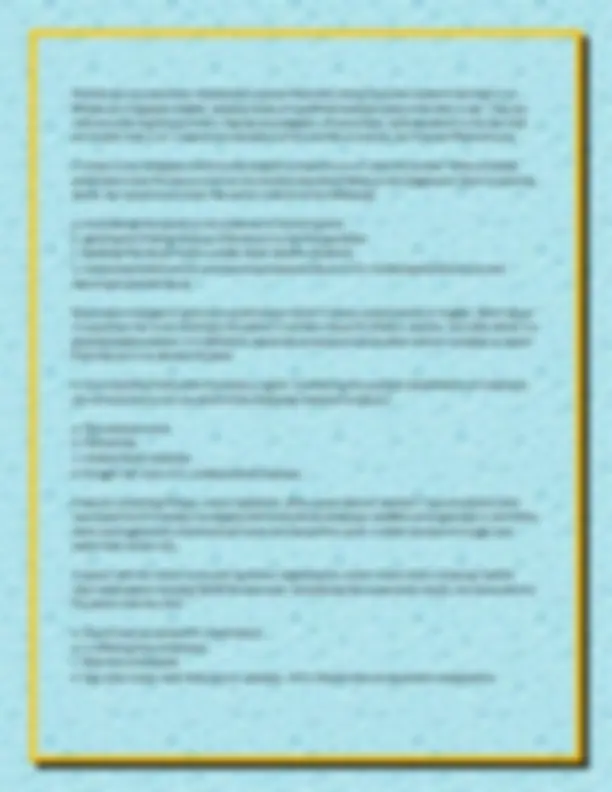
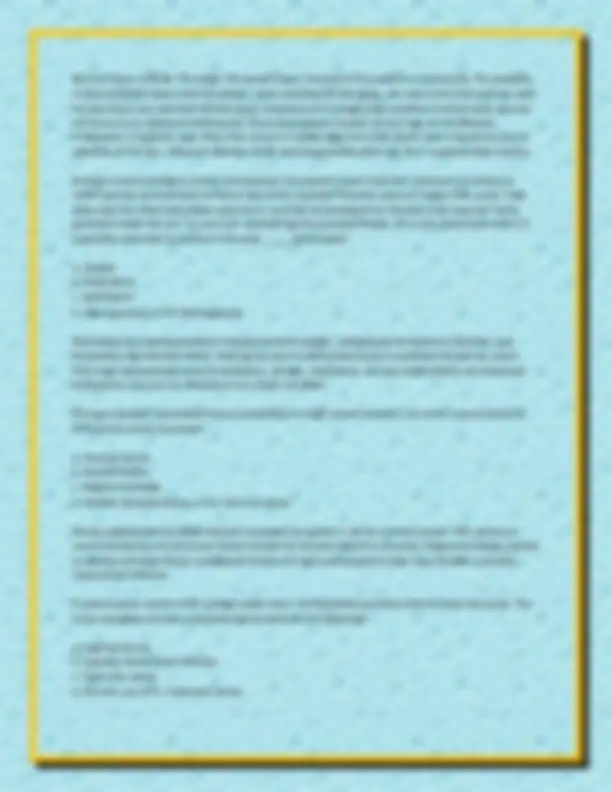
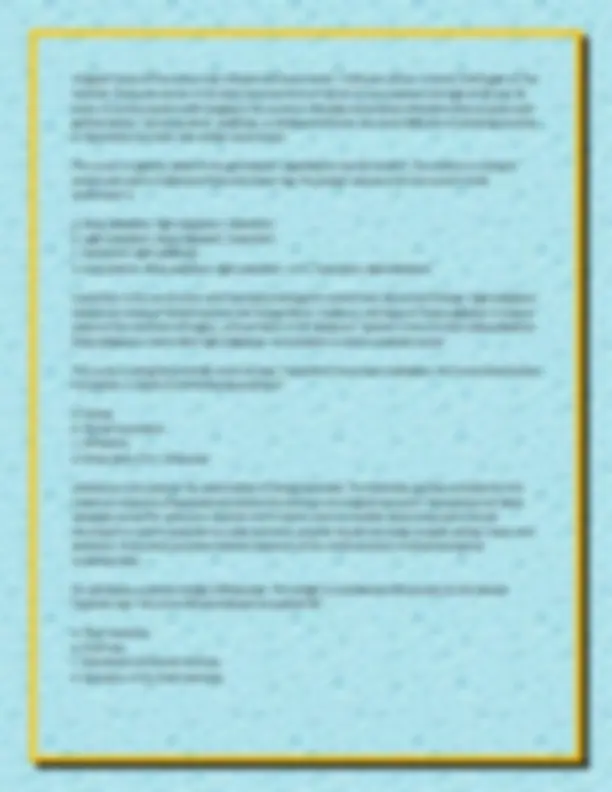
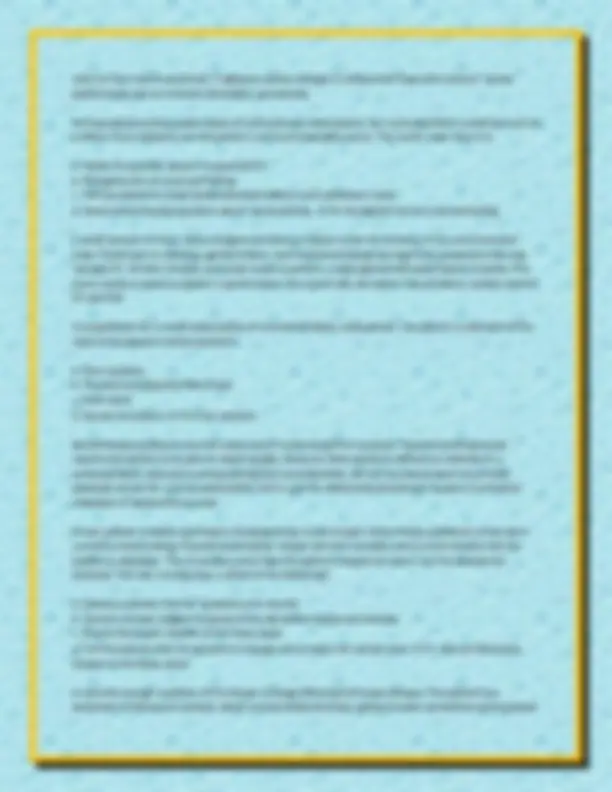
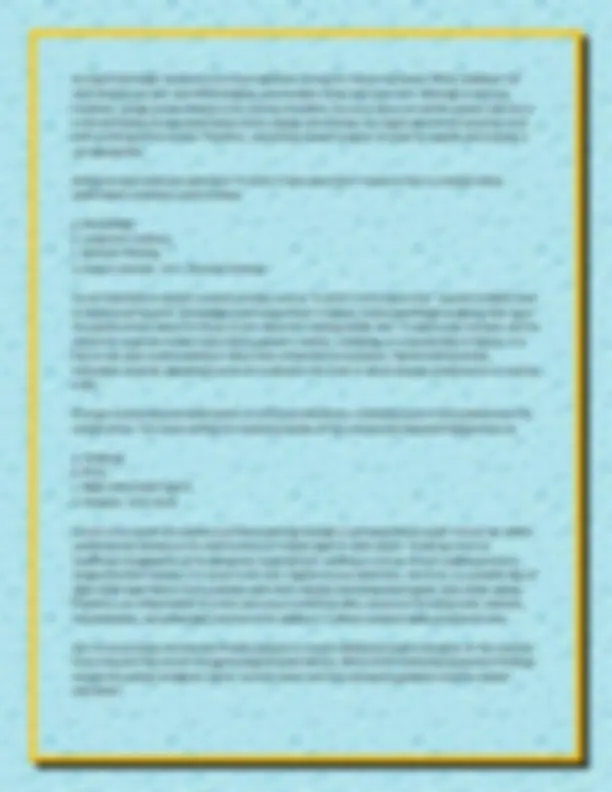
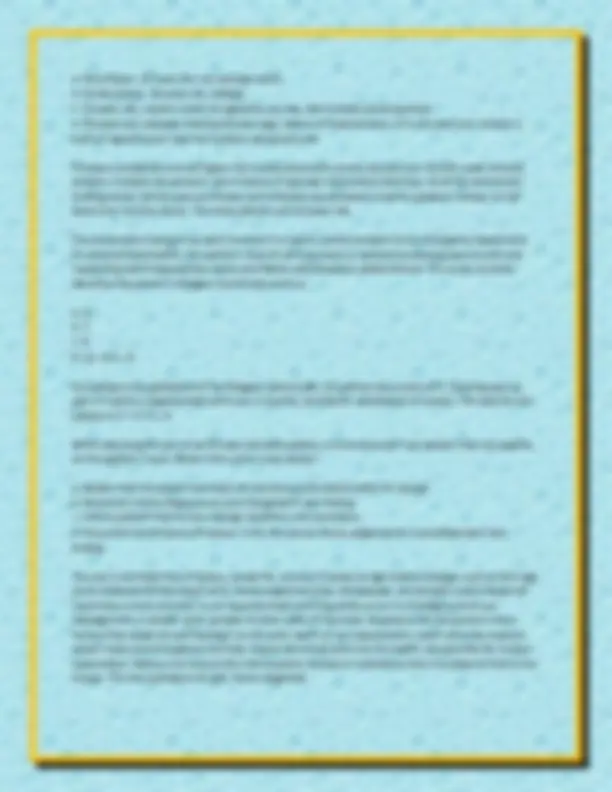
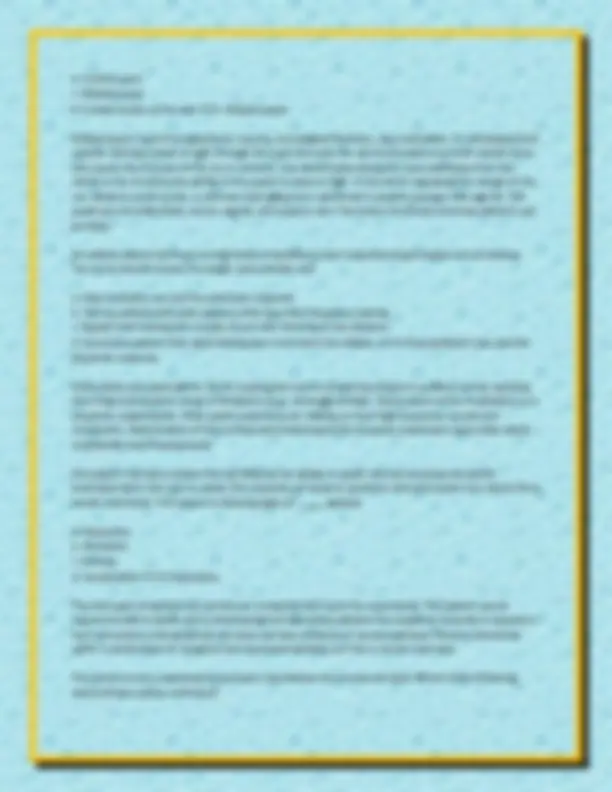
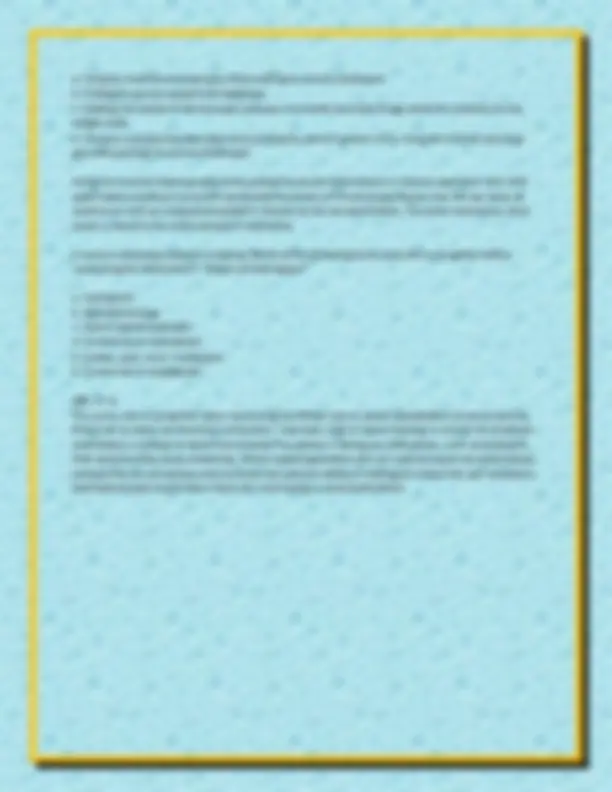


Study with the several resources on Docsity

Earn points by helping other students or get them with a premium plan


Prepare for your exams
Study with the several resources on Docsity

Earn points to download
Earn points by helping other students or get them with a premium plan
Community
Ask the community for help and clear up your study doubts
Discover the best universities in your country according to Docsity users
Free resources
Download our free guides on studying techniques, anxiety management strategies, and thesis advice from Docsity tutors
Fundamentals of Nursing Chapter 30 Health Assessment and Physical Examination
Typology: Exercises
1 / 14

This page cannot be seen from the preview
Don't miss anything!









Fundamentals of Nursing Chapter 30: Health Assessment and Physical Examination A nurse is a preceptor for a nurse who just graduated from nursing school. When caring for a patient, the new graduate nurse begins to explain to the patient the purpose of completing a physical assessment. Which of the following statements made by the new graduate nurse requires the preceptor to intervene? a. "I will use the information from my assessment to figure out if your antihypertensive medication is working effectively." b. "Nursing assessment data are used only to provide information about the effectiveness of your medical care." c. "Nurses use data from their patient's physical assessment to determine a patient's educational needs." d. "Information gained from physical assessment helps nurses better understand their patients' emotional needs." ✔✔b. "Nursing assessment data are used only to provide information about the effectiveness of your medical care." Nursing assessment data are used to evaluate the effectiveness of all aspects of a patient's care, not just the patient's medical care. Assessment data help to evaluate the effectiveness of medications and to determine a patient's health care needs, including the need for patient education. Nurses also use assessment data to identify patients' psychosocial and cultural needs. Having misplaced his stethoscope, a nurse borrows a colleague's stethoscope. He next enters the patient's room and identifies himself, washes his hands with soap, and states the purpose of his visit. He performs proper identification of the patient before he auscultates her lungs. Which critical health assessment step was not performed? a. Running warm water over stethoscope for patient comfort b. Cleaning stethoscope with Betadine c. Using alcohol-based hand disinfectant d. Cleaning stethoscope with alcohol ✔✔d. Cleaning stethoscope with alcohol Bacteria and viruses can be transferred from patient to patient when a stethoscope that is not clean is used. The stethoscope should be cleaned before use on each patient. Running water over the stethoscope does not kill bacteria. Betadine is an inappropriate cleaning solution and may damage the equipment. Hand sanitizer is not an approved cleaning product. Which is the best examination position for a complete geriatric physical examination on a weak patient with bilateral basilar pneumonia? a. Prone position b. Sims' position c. Supine position d. Lateral recumbent ✔✔c. Supine position
This is the most normally relaxed position. It will not compromise the patient's breathing because it is likely compromised with pneumonia. If the patient becomes short of breath easily, raise the head of the bed. This position would be easiest for an elderly weak person to get into position for an examination. Lateral recumbent and prone positions cause respiratory difficulty for any patient with respiratory difficulties. Sims' position is used for assessment of the rectum and the vagina. During an annual gynecological examination, a college student discusses her upcoming college break at a tropical location. After the student receives an oral contraceptive prescription, the nurse identifies the importance of skin cancer prevention education by discussing which evidence-based prevention health topic? a. Applying water-based sunscreen only before swimming b. Using tanning bed daily for 7 days before college break trip c. Applying broad-spectrum sunscreen of SPF 5 d. Taking extra precautions in the sun secondary to the prescription ✔✔d. Taking extra precautions in the sun secondary to the prescription Oral contraceptives can make the skin more sensitive to the sun. For this reason, the patient should be educated about the need for sun protection such as wide-brimmed hats, use of broad-spectrum sunscreen of SPF 15 or greater, not tanning during midday, and not using tanning beds. Broad-spectrum sunscreens should be applied 15 minutes before going into the sun and after swimming or perspiring. Tanning parlors, sunlamps, etc., should be avoided. Sunscreens with SPF of 15 or greater should be used. A head and neck physical examination is completed on a 50-year-old female patient. All physical findings are normal except for fine brittle hair. Based on the physical findings, which of the following laboratory tests would the nurse expect to be ordered? a. Liver function test b. Lead level c. Thyroid-stimulating hormone test d. Complete blood count ✔✔c. Thyroid-stimulating hormone test Thyroid disease can make hair thin and brittle. Liver function testing is indicated for a patient who has jaundice. Lead levels and a CBC are not indicated for the presence of brittle hair. A febrile preschool-aged child presents to the after-hours clinic. Varicella is diagnosed on the basis of the illness history and the presence of small, circumscribed skin lesions filled with serous fluid. The nurse documents the varicellar lesions as which type of skin lesion? a. Vesicle b. Wheal c. Papule d. Pustule ✔✔a. Vesicle
Normal vision is 20/20. The larger the denominator, the poorer the patient's visual acuity. For example, a value of 20/60 means that the patient, when standing 20 feet away, can read a line that a person with normal vision can read from 60 feet away. Strabismus is a (congenital) condition in which both eyes do not focus on an object simultaneously: These eyes appear crossed. Acuity may not be affected. Presbyopia is impaired near vision that occurs in middle-aged and older adults and is caused by loss of elasticity of the lens. Cataracts develop slowly and progressively after age 35 or suddenly after trauma. During a routine pediatric history and physical, the parents report that their child was a premature infant and was so small that he had to stay in the neonatal intensive care unit longer than usual. They state that the infant was yellow when born, and that he developed an infection that required "every antibiotic under the sun" to cure him. Considering the neonatal history, the nurse determines that it is especially important to perform a focused _____ examination. a. Cardiac b. Respiratory c. Ophthalmic d. Hearing acuity ✔✔d. Hearing acuity Risk factors for hearing problems include low birth weight, nonbacterial intrauterine infection, and excessively high bilirubin levels. Hearing loss due to ototoxicity (injury to auditory nerves) can result from high maintenance doses of antibiotics. Cardiac, respiratory, and eye examinations are important assessments but are not relevant to this child's condition. During a sexually transmitted illness presentation to high school students, the nurse recommends the HPV vaccine series to prevent a. Cervical cancer. b. Genital lesions. c. Vaginal discharge. d. Swollen perianal tissues. ✔✔a. Cervical cancer. Human papillomavirus (HPV) infection increases the person's risk for cervical cancer. HPV vaccine is recommended by the American Cancer Society for females aged 9 to 26 years. Vaginal discharge, painful or swollen perianal tissues, and genital lesions are signs and symptoms that may indicate a sexually transmitted infection. A male student comes to the college health clinic. He hesitantly describes that his testis has lumps. The nurse recognizes this as a potential sign of which of the following? a. Inguinal hernia b. Sexually transmitted infection c. Testicular cancer d. Diuretic use ✔✔c. Testicular cancer
Irregular lumps of the testes may indicate testicular cancer. Testicular cancer is cancer that begins in the testicles. Testicular cancer is the most common form of cancer in men between the ages of 15 and 35 years. A hernia presents with bulging in the scrotum. Sexually transmitted infections often present with genital lesions. Use of diuretics, sedatives, or antihypertensives can cause difficulty in achieving erection or ejaculation but does not usually cause lumps. The nurse is urgently called to the gymnasium regarding an injured student. The student is crying in severe pain with a malformed fractured lower leg. The proper sequence for the nurse's initial assessment is a. Deep palpation, light palpation, inspection. b. Light palpation, deep palpation, inspection. c. Inspection, light palpation. d. Auscultation, deep palpation, light palpation. ✔✔c. Inspection, light palpation. Inspection is the use of vision and hearing to distinguish normal from abnormal findings. Light palpation determines areas of tenderness and skin temperature, moisture, and texture. Deep palpation is used to examine the condition of organs, such as those in the abdomen. Caution is the rule with deep palpation. Deep palpation is done after light palpation. Auscultation is used to evaluate sound. The nurse is caring for a female victim of rape. To perform the proper evaluation, the nurse should place the patient in which of the following positions? a. Sitting b. Dorsal recumbent c. Lithotomy d. Knee-chest ✔✔c. Lithotomy Lithotomy is the position for examination of female genitalia. The lithotomy position provides for the maximum exposure of genitalia and allows the insertion of a vaginal speculum. Sitting does not allow adequate access for speculum insertion and is better used to visualize upper body parts. Dorsal recumbent is used to examine the head and neck, anterior thorax and lungs, breasts, axillae, heart, and abdomen. Knee-chest provides maximal exposure of the rectal area but is embarrassing and uncomfortable. On admission, a patient weighs 250 pounds. The weight is recorded as 256 pounds on the second inpatient day. The nurse should evaluate the patient for a. Fluid retention. b. Fluid loss. c. Decreased nutritional reserves. d. Anorexia. ✔✔a. Fluid retention.
The diagnosis of entropion can lead to lashes of the lids irritating the conjunctiva and cornea. Irritation can lead to infection. Ectropion is when the eyelid margins turn out so that the lashes do not irritate the conjunctiva. Exophthalmos is a bulging of the eyes and usually indicates hyperthyroidism. Strabismus, or crossing of the eyes, results from neuromuscular injury or inherited abnormalities. During a school physical examination, the nurse reviews the patient's current medical history. With a positive medical history of asthma, eczema, and allergic rhinitis, the nurse expects which physical finding on nasal examination? a. Polyp b. Yellow discharge c. Pale nasal mucosa d. Puffiness of nasal mucosa ✔✔c. Pale nasal mucosa Pale nasal mucosa with clear mucoid discharge indicates allergic rhinitis. Polyps are tumorlike growths. Yellow discharge would be seen with infection. Habitual use of intranasal cocaine and opioids causes puffiness and increased vascularity of the nasal mucosa. Objective physical data describe air moving through small airways over the lung's periphery. The expected inspiratory-to-expiratory phase of this normal vesicular breath sound is which of the following? a. The inspiratory phase lasts exactly as long as the expiratory phase. b. The expiration phase is longer than the inspiration phase. c. The expiration phase is two times longer than the inspiration phase. d. The inspiratory phase is three times longer than the expiratory phase. ✔✔d. The inspiratory phase is three times longer than the expiratory phase. Vesicular breath sounds are normal breath sounds; the inspiratory phase is three times longer than the expiratory phase. Bronchovesicular breath sounds have an inspiratory phase equal to the expiratory phase. Bronchial breath sounds have an expiration phase longer than the inspiration phase at a 3: ratio. A teen female patient reports intermittent abdominal pain for 12 hours. No dysuria is present. When performing an abdominal assessment, the nurse should a. Recommend that the patient take more laxatives. b. Ask the patient about the color of her stools. c. Avoid sexual references such as possible pregnancy. d. Assess first the spots that are most tender. ✔✔b. Ask the patient about the color of her stools. Black or tarry stools (melena) indicate gastrointestinal alteration. The nurse should caution patients about the dangers of excessive use of laxatives or enemas. Determine if the patient is pregnant, and
note her last menstrual period. Pregnancy causes changes in abdominal shape and contour. Assess painful areas last to minimize discomfort and anxiety. During a genitourinary examination of a 30-year-old male patient, the nurse identifies a small amount of a white, thick substance on the patient's uncircumcised glans penis. The nurse's next step is to a. Notify his provider about a suspected STI. b. Recognize this as a normal finding. c. Tell the patient to avoid doing self-examinations until symptoms clear. d. Avoid embarrassing questions about sexual activity. ✔✔b. Recognize this as a normal finding. A small amount of thick, white smegma sometimes collects under the foreskin in the uncircumcised male. Penile pain or swelling, genital lesions, and urethral discharge are signs and symptoms that may indicate STI. All men 15 years and older need to perform a male-genital self-examination monthly. The nurse needs to assess a patient's sexual history and use of safe sex habits. Sexual history reveals risks for STI and HIV. In preparation for a rectal examination of a nonambulatory male patient, the patient is informed of the need to be placed in which position? a. Sims' position b. Forward bending with flexed hips c. Knee-chest d. Dorsal recumbent ✔✔a. Sims' position Nonambulatory patients are best examined in a side-lying Sims' position. Forward bending would require the patient to be able to stand upright. Knees to chest would be difficult to maintain in a nonambulatory male and is embarrassing and uncomfortable. Dorsal recumbent does not provide adequate access for a rectal examination and is used for abdominal assessment because it promotes relaxation of abdominal muscles. A teen patient is tearful and reports locating lumps in her breasts. Other history obtained is that she is currently menstruating. Physical examination reveals soft and movable cysts in both breasts that are painful to palpation. The nurse also notes that the patient's nipples are erect, but the areolae are wrinkled. The next nursing step is which of the following? a. Reassure patient that her symptoms are normal. b. Consult a breast surgeon because of the abnormal nipples and areolae. c. Discuss fibrocystic disease as the likely cause. d. Tell the patient that the symptoms may get worse when her period ends. ✔✔c. Discuss fibrocystic disease as the likely cause. A common benign condition of the breast is benign (fibrocystic) breast disease. This patient has symptoms of fibrocystic disease, which include bilateral lumpy, painful breasts sometimes accompanied
a. Nonsmoker, 13 years old, not sexually active b. Social smoker, 15 years old, celibate c. 22 years old, smokes 1 pack of cigarettes per day, has multiple sexual partners d. 50 years old, stopped smoking 30 years ago, history of hysterectomy ✔✔c. 22 years old, smokes 1 pack of cigarettes per day, has multiple sexual partners Females considered to be at higher risk include those who smoke and are over 21 with weak immune systems, multiple sex partners, and a history of sexually transmitted infections. Of all the assessment findings listed, the 22-year-old smoker with multiple sexual partners has the greatest number of risk factors for cervical cancer. The other patients are at lower risk. The paramedics transport an adult involved in a motor vehicle accident to the emergency department. On physical examination, the patient's level of consciousness is reported as opening eyes to pain and responding with inappropriate words and flexion withdrawal to painful stimuli. The nurse correctly identifies the patient's Glasgow Coma Scale score as a. 5. b. 7. c. 9. d. 11. ✔✔c. 9. According to the guidelines of the Glasgow Coma Scale, the patient has a score of 9. Opening eyes to pain is 2 points; inappropriate word use is 3 points; and flexion withdrawal is 4 points. The total for this patient is 2 + 3 + 4 = 9. While assessing the skin of an 82-year-old male patient, a nurse discovers non-painful ruby red papules on the patient's trunk. What is the nurse's next action? a. Explain that the patient has basal cell carcinoma and should watch for spread. b. Document cherry angiomas as a normal geriatric skin finding. c. Tell the patient that he has a benign squamous cell carcinoma. d. Document the presence of edema. ✔✔b. Document cherry angiomas as a normal geriatric skin finding. The skin is normally free of lesions, except for common freckles or age-related changes such as skin tags, senile keratosis (thickening of skin), cherry angiomas (ruby red papules), and atrophic warts. Basal cell carcinoma is most common in sun-exposed areas and frequently occurs in a background of sun- damaged skin; it almost never spreads to other parts of the body. Squamous cell carcinoma is more serious than basal cell and develops on the outer layers of sun-exposed skin; these cells may travel to lymph nodes and throughout the body. Report abnormal lesions to the health care provider for further examination. Edema is an area of skin that becomes swollen or edematous from a buildup of fluid in the tissues. This has nothing to do with cherry angiomas.
During a preschool readiness examination, the nurse prepares to perform visual acuity screenings. Given the children's age, the best equipment to test central vision is which of the following? a. Snellen test b. E chart c. Reading test d. Penlight ✔✔b. E chart The E chart is used when an individual is unable to read, as would be the case for a preschool-aged child. A Snellen chart and a reading test are too advanced for a preschooler's education level. A penlight is used to check light perception. Shine a penlight into the eye, and then turn it off. If the patient notes when the light is turned on or off, light perception is intact. A nurse suspects an abnormal thyroid shape during the physical examination. The nurse offers the patient a glass of water and observes her drinking to a. Visualize an enlarged thyroid gland. b. Evaluate for exostosis. c. Test the patient's gag reflex. d. Visualize the uvula and soft palate. ✔✔a. Visualize an enlarged thyroid gland. This technique is used to visual an abnormally large thyroid gland. Normally, the thyroid cannot be visualized. An exostosis is a bony growth between the two palates that is noted when the oral cavity is examined. The patient's gag reflex is tested by placing a tongue depressor on the posterior tongue. The uvula and soft palate are visualized by using a penlight. Both structures should rise centrally as the patient says, "Ah." The patient is a 54-year-old male with a medium frame. He weighs 148 pounds and is 5 feet 8 inches tall. The nurse realizes that this patient is a. Overweight. b. Underweight. c. At his desired weight. d. Obese. ✔✔c. At his desired weight. According to the Metropolitan Life Insurance Company Statistical Bulletin, a male of medium frame who is 5 feet 8 inches tall should weigh between 145 and 157 pounds. This patient is at his desired weight. He is not overweight, underweight, or obese. A patient in the emergency department is complaining of left lower abdominal pain. The comprehensive abdominal examination would include, in proper order, which of the following? a. Inspection, palpation, auscultation b. Percussion, inspection, auscultation
b. A black pupil c. Dilated pupils d. A black fundus of the eye ✔✔c. Dilated pupils Dilated pupils result from glaucoma, trauma, neurological disorders, eye medication, or withdrawal from opioids. Shining a beam of light through the pupil and onto the retina stimulates the third cranial nerve and causes the muscles of the iris to constrict. Any abnormality along the nerve pathways from the retina to the iris alters the ability of the pupils to react to light. A thin white ring along the margin of the iris, called an arcus senilis, is common with aging but is abnormal in anyone younger than age 40. The pupils are normally black, round, regular, and equal in size. The fundus of African American patients can be black. An elderly patient has been on high doses of antibiotics and is experiencing a sudden loss of hearing. The nurse should contact the health care provider and a. Stop antibiotic use until the physician responds. b. Tell the patient that older patients often lose low-frequency hearing. c. Explain that hearing loss usually occurs with thinning of the eardrum. d. Assure the patient that rapid hearing loss is normal in the elderly. ✔✔a. Stop antibiotic use until the physician responds. Older adults are especially at risk for hearing loss due to ototoxicity (injury to auditory nerve) resulting from high maintenance doses of antibiotics (e.g., aminoglycosides). Continuation of the medications is a physician responsibility. Older adults experience an inability to hear high-frequency sounds and consonants. Deterioration of the cochlea and thickening of the tympanic membrane cause older adults to gradually lose hearing acuity. The patient has had a stroke that has affected her ability to speak, and she becomes extremely frustrated when she tries to speak. She responds correctly to questions and instructions but cannot form words coherently. This patient is showing signs of _____ aphasia. a. Expressive b. Receptive c. Sensory d. Combination ✔✔a. Expressive The two types of aphasia are sensory (or receptive) and motor (or expressive). The patient cannot express herself in words and is showing signs of expressive aphasia. She responds correctly to questions and instructions, indicating that she does not have receptive or sensory aphasia. Patients sometimes suffer a combination of receptive and expressive aphasia, but this is not the case here. The school nurse is assessing the tympanic membranes of a 3-year-old child. Which of the following demonstrates proper technique?
a. Using an inverted otoscope grip while pulling the auricle downward b. Pulling the auricle upward and backward c. Holding the handle of the otoscope between the thumb and index finger while the child lies on the weight scale d. Using an inverted otoscope grip while pulling the auricle upward ✔✔a. Using an inverted otoscope grip while pulling the auricle downward Using the inverted otoscope grip while pulling the auricle downward is a common approach with child examinations because it prevents accidental movement of the otoscope deeper into the ear canal, as could occur with an unexpected pediatric reaction to the ear examination. The other techniques could result in injury to the child's tympanic membrane. A nurse is assessing a patient's hearing. Which of the following items does the nurse gather before conducting the assessment? (Select all that apply.) a. Tuning fork b. Ophthalmoscope c. Cotton-tipped applicator d. Current list of medications e. Snellen chart ✔✔a. Tuning fork d. Current list of medications ANS: A, D The nurse uses a tuning fork when conducting the Weber test to assess lateralization of sound and the Rinne test to assess air and bone conduction—two tests used to assess hearing. A current list of patient medications is needed to determine whether the patient is taking any medications, such as antibiotics, that could possibly cause ototoxicity. Cotton-tipped applicators are not used during an ear examination; instead they are sometimes used to assess the patient's ability to distinguish sharp from dull sensations. Ophthalmoscopes and Snellen charts are used during a visual examination.